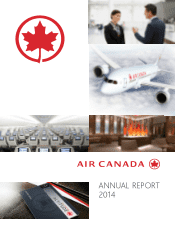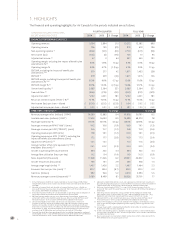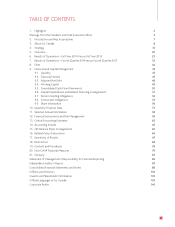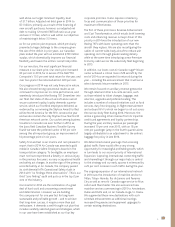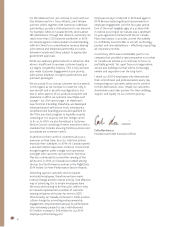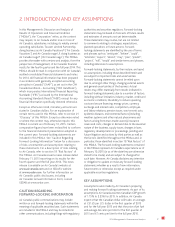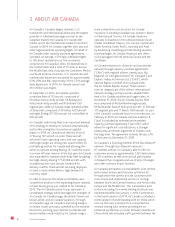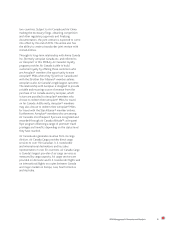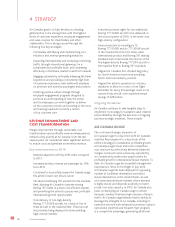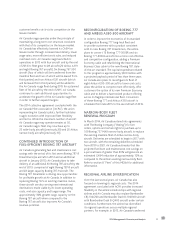Air Canada 2014 Annual Report Download - page 11
Download and view the complete annual report
Please find page 11 of the 2014 Air Canada annual report below. You can navigate through the pages in the report by either clicking on the pages listed below, or by using the keyword search tool below to find specific information within the annual report.
11
2014 Management’s Discussion and Analysis 11
2014 Management’s Discussion and Analysis
customer benefits vis-à-vis its competitors in the
leisure markets.
Air Canada rouge operates under the principle of
maintaining a long-term cost structure consistent
with that of its competitors in the leisure market.
Air Canada has effectively lowered its CASM on
leisure routes through increased seat density, lower
wage rates, more efficient work rules, and reduced
overhead costs. Air Canada rouge launched its
operations in 2013 with four aircraft and by the end
of 2014 its fleet grew to 28 aircraft (20 Airbus A319
and eight Boeing 767 aircraft). Six Boeing 767-300
aircraft (four of which will be transferred from the
mainline fleet and two of which will be leased from
third parties) and two Airbus A321 aircraft (which
will be leased from third parties) will be added to
the Air Canada rouge fleet during 2015 for a planned
fleet of 36 aircraft by the end of 2015. Air Canada
continues to seek additional opportunities to
accelerate the growth of the Air Canada rouge fleet
in order to further expand margins.
The 2014 collective agreement concluded with the
Air Canada Pilots Association (“ACPA”), the union
representing Air Canada’s pilots, further facilitates
rouge’s evolution with improved fleet flexibility
and terms. While the maximum number of aircraft
Air Canada rouge may operate remains at 50,
Air Canada rouge’s fleet may now have up to
25 wide-body aircraft (previously 20) and 25 Airbus
narrow-body aircraft (previously 30).
CONTINUED INTRODUCTION OF
FUEL-EFFICIENT BOEING 787 AIRCRAFT
Air Canada is generating fuel and maintenance cost
savings with the arrival of its first seven Boeing 787-8
Dreamliners (six aircraft in 2014 and an additional
aircraft in January 2015). Air Canada plans to take
delivery of an additional 30 Boeing 787 aircraft by the
end of 2019, comprised of eight Boeing 787-8 aircraft
and 22 larger capacity Boeing 787-9 aircraft. The
Boeing 787 Dreamliner is driving new opportunities
for profitable growth at Air Canada. In addition to
replacing Boeing 767s on existing mainline routes,
these aircraft are also serving new international
destinations made viable by its lower operating
costs, mid-size capacity and longer range. The
approximately 30% greater cargo capacity on the
Boeing 787 aircraft when compared to the
Boeing 767 aircraft also improves Air Canada’s
revenue potential.
RECONFIGURATION OF BOEING 777
AND AIRBUS A330-300 AIRCRAFT
In order to improve the economics of its standard
configuration Boeing 777 long-haul fleet and
to provide customers with a product consistent
with its new Boeing 787 Dreamliners, the airline
plans to convert 12 Boeing 777-300ER and six
Boeing 777-200LR aircraft into a more cost effective
and competitive configuration, adding a Premium
Economy cabin and refurbishing the International
Business Class cabin to the new Boeing 787 state-
of-the-art standard. The capital expenditure related
to this program is approximately $300 million with
a projected payback period of less than three years.
Air Canada also plans to reconfigure its fleet of
eight Airbus A330-300 aircraft to lower unit costs,
allow the airline to compete more effectively, offer
customers the option of its new Premium Economy
cabin and to deliver a harmonized product offering
across its flagship international fleet. Conversion
of these Boeing 777 and Airbus A330 aircraft is
scheduled from late 2015 to the second half of 2016.
NARROW-BODY FLEET
RENEWAL PROGRAM
In March 2014, Air Canada entered into agreements
with The Boeing Company (“Boeing”) for firm
orders, options and certain rights to purchase up to
109 Boeing 737 MAX narrow-body aircraft, to replace
the existing mainline fleet of Airbus narrow-body
aircraft. Deliveries are scheduled to begin in 2017 with
two aircraft, with the remaining deliveries scheduled
from 2018 to 2021. Air Canada estimates that the
projected fuel burn and maintenance cost savings on
a per seat basis of greater than 20% will generate an
estimated CASM reduction of approximately 10% as
compared to the airline’s existing narrow-body fleet.
Refer to section 8 “Fleet” of this MD&A for additional
information.
REGIONAL AIRLINE DIVERSIFICATION
Over the last several years, Air Canada has also
focused on lowering its regional costs. The 2014
agreement concluded with ACPA provides increased
flexibility in the airline’s relationships with regional
airlines and Air Canada may also replace Bombardier
CRJ-100/200 and Bombardier Dash 8-100/300 aircraft
with Bombardier Dash 8-Q400 aircraft under certain
conditions. Furthermore, the airline has diversified
its regional operations across multiple regional
partners. For example, in 2013, Air Canada transferred

